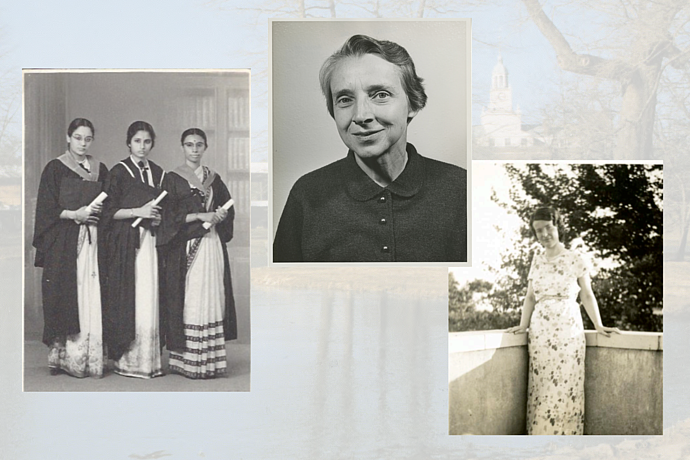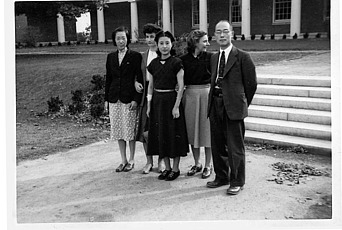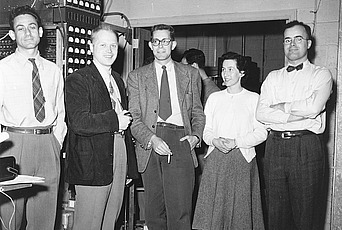
Losing Track and Finding Traces of the Institute’s Lesser-Known Histories
The Institute for Advanced Study welcomed its first class of Members (then known as “Workers”) in 1933. In the 90 years since, the Institute has welcomed over 8,000 Members comprising scholars from nearly every part of the globe. For many of these scholars, the Shelby White and Leon Levy Archives Center holds some of the only extant archival records documenting their life and work. The Archives Center answers hundreds of requests a year related to household names like Albert Einstein, T. S. Eliot, and J. Robert Oppenheimer; however, just as frequently, it receives requests for information regarding scholars with lesser-known histories and is often one of the few places where researchers can turn to find the remaining traces of those scholars’ stories. The Archives Center has assisted with major efforts to track these “lost” scholars ranging from Patrizia Guarnieri’s publication Intellectuals Displaced from Fascist Italy: Migrants, Exiles and Refugees Fleeing for Political and Racial Reasons to Scientific American and PRX’s podcast Lost Women of Science.
Over the past year, the Archives Center has taken steps to learn more about the Institute’s earliest female-identifying members, like Mabel Schmeiser Barnes and Anna Stafford Henriques. Most recently, archivists spent a significant amount of time researching one of the earliest women of color at the IAS: Thayyoor K. Radha. Radha joined the School of Mathematics/Natural Sciences in 1965 under then Director J. Robert Oppenheimer during a period of significant growth for the Institute. Radha earned distinction as a scholar at the University of Madras, studying under another former Member Alladi Ramakrishnan (School of Mathematics/Natural Sciences, 1957–58). Radha’s story is deeply intertwined with Ramakrishnan’s experience at the Institute.

Having come to IAS under the invitation of Oppenheimer (after completing his own work under Homi Bhabha), Ramakrishnan returned to his home institution inspired to create an opportunity for young Indian scholars to experience the seminars that changed the course of his career during his time in the United States. When Ramakrishnan returned to India, he founded the Institute of Mathematical Science (MATSCIENCE) in present-day Chennai, where he advised Radha first as a doctoral student and then as a fellow. Ramakrishnan’s acceptance of Indian women into his program surprised even the most distinguished members of Indian society. In his memoir, former Minister C. Subramaniam recalls the shock expressed by Prime Minister Jawaharlali Nehru, when visiting MATSCIENCE, at discovering not only the enthusiasm of the students but “in particular … four girls among the students.”1
Of the four girls, Radha seemed perhaps the most impressive at that critical moment in time. In 1963, The Straits Times (published in Singapore where Radha’s sister had settled) printed an article explaining the young Radha’s accomplishments, along with the nuclear scientist’s image above a caption that read “Miss Radha … too busy to think of marriage.” Indeed, in the years between 1963 and 1966, Radha’s career as a physicist featured incredible success. In 1963, Radha held a post-doctoral fellowship at Stanford University under physicist Leonard I. Schiff (now famous for his Quantum Mechanics). In 1964, Radha co-authored “Slow Neutron-Deuteron Capture and the Structure of 3H and 3He” with Schiff and N. T. Meister for the Physical Review, and Schiff presented on the work at the International Conference of High Energy Physics and Nuclear Structure. After Radha returned to the University of Madras for her fellowship, she co-authored several papers with another female fellow R. Thunga, before applying to the Institute and being accepted in 1965. In this period, Radha’s name was featured on lectures across the United States—she was invited as far as UCLA by another former IAS Member (and a major advocate for women in science) Nina Byers (IAS School of Mathematics/Natural Sciences, 1964–65).
Today, few scholars recognize Radha’s name. Part of the difficulty lies in the traditional structures of twentieth-century society. Radha’s name is virtually undiscoverable after 1966 when she married Vembu Gourishankar, a professor in the Department of Electrical Engineering at the University of Alberta, and changed her name to Radha Gourishankar. It is only through the hard work of female mathematicians that there is an answer to what became of Dr. T. K. Radha after marriage. Professor Rachel Levy’s viral blog Grandma Got STEM featured Radha, along with three fellow physicists, in a 2018 post titled “My ‘Hidden Figures.’” Levy’s blog captures the amazing work of women that often goes under celebrated in comparison to academic achievements. Following her marriage and the birth of her children and grandchildren, Gourishankar’s scholarship turned toward service: teaching programming and caring for the sick.
Unfortunately, more often than not, the most marginalized scholars in academia can be the hardest to rediscover. Even for archivists, the work of uncovering marginalized communities in the archives can be especially challenging. Institutional records often leave little trace of identity—for better or worse, an individual’s race, ethnicity, gender, sexuality, ability, political affiliations, and economic class rarely feature in the archival descriptions created to help researchers identify their records. When these identity markers do appear, they are not without the troubled politics of their historical era.
But in recovering Radha Gourishankar’s lost history—and the legacies of other lost predecessors— scholars can unearth important insight into the historic landscape of their own scholarship, as Levy explains in her blog. These forgotten histories reveal the social constructs that shaped knowledge in the twentieth century. For Institute archivists, they illustrate the ways that Institute scholars impact one another. Across time and place, even some of the least-known of the Members play a critical part of the intellectual ecosystem of the Institute.
1 Bindu A. Bambah, “Women in High Energy Physics in Post Independent India,” Physics News: Bulletin of the Indian Physics Association January–June 2021, Vol. 51, No. 1–2.

